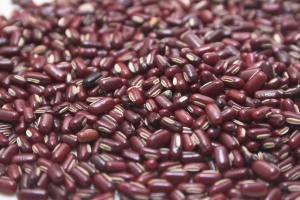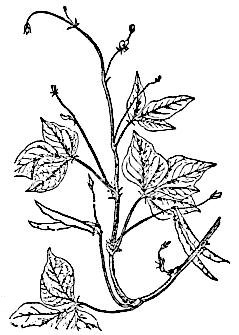Antiinfections.[5]
- Relieve nephritis, beriberi, and trophedema- Boil 100 g small red beans in
water with 300 g wax gourd. Drink as soup at meals once a day.
[4]
- Apply to a carbuncle to heal the swelling- Grind small red beans into powder
and mix with honey.
[4]
- Promote milk secretion after childbirth- Boil 100 g small red beans in water.
Eat at meals.
[4]
- Relieve abdominal pain due to blood coagulations after childbirth- Fry 300
g small red beans until charred. Add 6 bowlfuls of water and boil until water
is reduced to 3 bowlfuls. Add some brown sugar as seasoning. Drink 1 bowl
of soup each time, 3 times a day.
[4]
The Tang Materia Medica cautions that frequent ingestion of this bean can
lead to dryness.
[6]
- Leg Qi edema or Kidney deficiency, with
Carp
as a soup.
[6]
- Deficiency edema such as that associated with malnutrition, with
Arachis
hypogaea- Peanuts and
Ziziphus jujuba-
Red date.
[6]
- Phlegm or stagnant food clogging the chest and diaphragm, with
Gua
di.
[6]
- Mild cases of Damp Heat jaundice, with
Ephedra
sinica- Ma huang,
Forsythia suspensa-
Lian qiao,
Morus alba- Sang bai pi.
[6]
- Damp Heat bleeding hemorrhoids, with
Angelica
polymorpha- Dang gui. As a topically applied plaster this combination
can be used in treating abscesses and other toxic swellings.
[6]
[1] Barefoot Doctors Manual- Published by Madrona Publishers Seattle Washington
ISBN 0-914842-52-8
[2] A Complete English Dictionary of Medicinal Terms in Chinese Acupuncture
and Herbalism 1981- Henry Lu Chinese Foundations of Natural Health- The Academy
of Oriental Heritage, Vancouver, Canada.
[3] Medicated Diet of Traditional Chinese Medicine- Chief Editor- Hou Jinglun.
Associate Editors- Zhao Xin, Li Weidong, Liu Jianxin, Geng Chun-e, Li Guohua,
Li Shaohua. Geijing. Science & Technology Press 1994. ISBN 7-5304-1735-5/R.
309.
[4] Chinese System of Food Cures Prevention and Remedies. 1986
Lu,
Henry. Sterling Publishing Co., Inc. New York. USA. Distributed in Australia by
Capricorn Book Co. Pty Ltd. Lane Cove, NSW. ISBN 0-8069-6308-5.
[5] Translation notes from Gary Seiford and Hocu Huhn- NSW College of Natural
Therapies. Sydney Australia (1982).
[6] Chinese Herbal Medicine Materia Medica- Dan Bensky and Andrew Gamble- Eastland
Press 1986 Seattle Washington ISBN 0-939616-15-7
Images
1.
upload.wikimedia.org
by Krish Dulal CC BY-SA 3.0
2.
[1]
3.
ceb.wikipedia.org
by Samuel Wong CC BY-SA 2.5
Calcium, phosporus, iron, thiamine, ribflavin, nicotinc acid.[1]
[1] Chinese Herbal Medicine Materia Medica- Dan Bensky and Andrew Gamble- Eastland
Press 1986 Seattle Washington ISBN 0-939616-15-7

